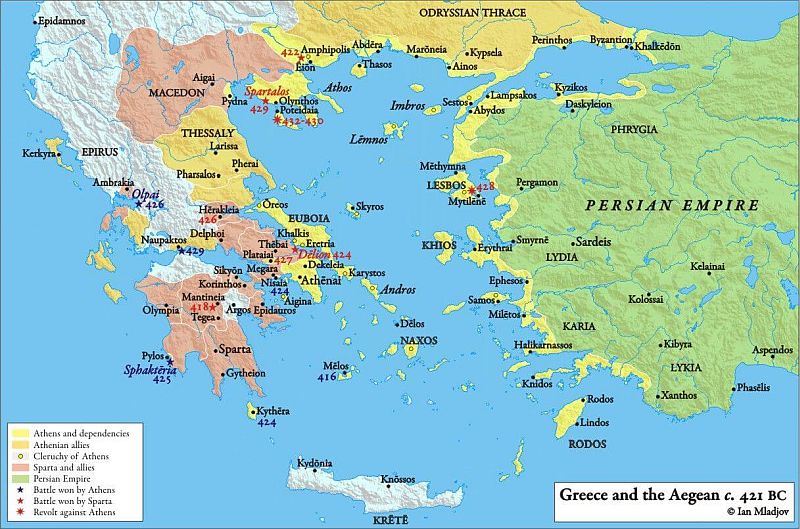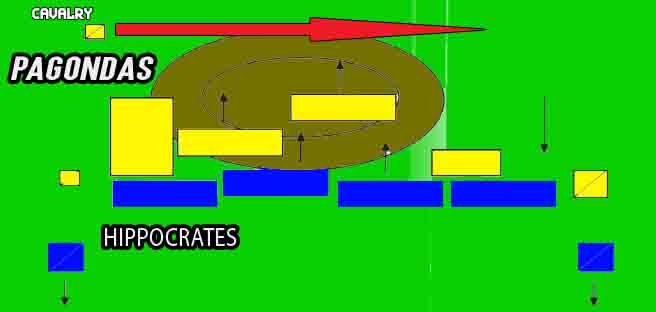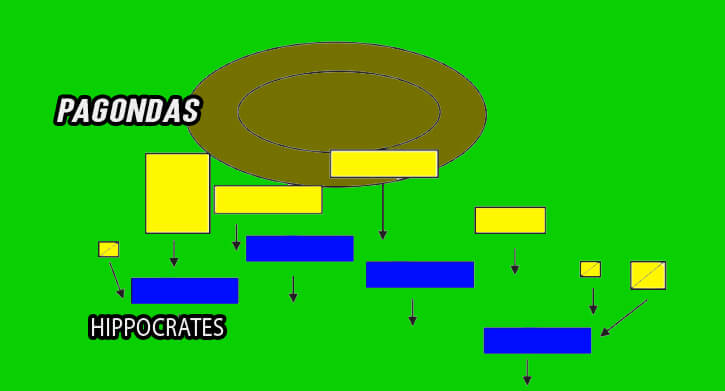The Battle of Delium(424 BC) represents one of the major turning points of the Peloponnesian War.
The decisive battle was fought between the Athenian army under the command of strategos Hippocrates and the forces of the Boeotian League under the leadership of the brilliant Theban commander, Pagondas.
The Boeotian League was the most critical Spartan ally outside the Peloponnesian Peninsula.
After achieving some remarkable victories against Sparta in Peloponnese, Athens suddenly shifted its attention against the most important Spartan ally, the Boeotian League.
By knocking the Boeotian League out of the war, the Athenians hoped to isolate Sparta and force them to the negotiation talks, thus ending the war.
The result was the Battle of Delium, where the Athenian plan backfired.
I.Historical Background

At the beginning of the Peloponnesian War, both Sparta and Athens developed different strategies for winning the war.
Battle of Delium – the audio version of the article
While the Spartan strategy was to simply invade and pillage rural Attica every year in an attempt to provoke the Athenians into an open battle, the Athenians found a more elaborate strategy.
By fortifying inside their city walls, and using their naval supremacy, the Athenians started to raid the main ports, cities, and colonies of the Peloponnesian Peninsula.
This allowed the Athenian forces to achieve remarkable victories against the Spartans at Pylos and Sphacteria in 425 BC.
By winning these battles the Athenians not only gained a foothold in Peloponesse, from which they can raid directly the entire Peloponnese but also knocked out the Spartan morale.
In 424 B.C the Athenians obtained another major victory by capturing the strategically important port city of Cythera.
You may wonder why the capture of Cythera was so important?
First, Cythera was located exactly south of the Laconian coast, so its location was very good for organizing future raids against the Spartans.
Secondly, the port city guarded the important trade routes for the goods coming from Africa.
The Athenian victories at Pylos, Sphacteria, and Cythera meant that the Spartans were now kept in check and the Athenians gained the upper hand in this phase of the war.
Emboldened by these crucial victories against the Spartans, the Athenian army turned its attention against the most important ally of the Spartans outside Peloponnese: the Boeotian League.
The result would be the Battle of Delium.
II.Battle of Delium: the Athenian strategy
The military victories against the Spartans at Pylos, Spacteria, and Cythera allowed the Athenians to shift their focus and concentrate their forces for a major military land campaign.
With the Spartans now at the mercy of the Athenian naval raids, the overconfident leaders of Athens considered that this was the best time to attempt to eliminate one of the key major allies of Sparta, the Boeotian League.
You may wonder why Athens suddenly turned its attention from Sparta towards the Boeotian League and decided to offer battle in the open field?
First, the Boeotians were supplying the Spartan invasions of Attica.
Secondly, the Athenians hoped to quickly get rid of a second battlefront. Facing both the Spartans and the Boeotians at the same time would not result in a quick victory. The dilemma of a prolonged two-front war had an enormous importance in the Athenian decision.
Lastly, the Athenians hoped that by crushing the Boeotian League, they could convert the Boeotian cities to democratic regimes that would join the Delian League and support further war efforts against Sparta.
During the summer of the year 424 B.C the Athenian Strategos, Demosthenes and Hippocrates, received news from democratic factions inside the Boeotian cities that they will rise up and organize a rebellion if the Athenians will come to their aid. According to historian Thucydides, the leader of this democratic group from Boeotia was a Theban exile by the name of Ptoeodorus.
The campaign plan which resulted from these negotiations, though ingenious and elaborate, was very ambitious.
The Athenian plan involved the synchronization of three major attacks.
Two of these attacks were to be led by Athenian leaders, Demosthenes and Hippocrates.
Demosthenes was entrusted with leading a naval expeditionary force against the South of Boeotia, while Hippocrates was responsible for the land operations.
The third attack was to be organized from within the Boeotian cities by the democratic rebels. If successful, the rebellion would facilitate the overthrow of the Oligarchic regimes, and the quick occupation of the enemy cities by Demosthenes and Hippocrates’s forces.
The keys to the success of this major Athenian campaign were synchronization and the element of surprise.
Demosthenes’s invasion force(which consisted of 400 hoplites, and some troops from Athenian allied city-states) would seize the town of Siphae, from the Gulf of Crisa(Southern part of Boeotia). The attack would be supported by the rebels inside the city.
At the same time, the democratic faction inside the city of Chaeronea would stage a rebellion, overthrow the oligarchic regime and occupy the city.
Hippocrates would support these attacks by marching with the main Athenian army at the Temple of Apollo, near the city of Delium.
Once the Temple of Apollo was occupied, Hippocrates forces would start building fortifications and convert Delium into an outpost for future raids into Boeotia.
It was assumed that even if the democratic revolutions did not have the expected success, at least Delium would serve as a military base for future raids against the Boeotian League cities.
The Athenians choose the three-pronged attack strategy so they can force the Boeotian League army to spread on multiple fronts, thus preventing their main army from concentrating their forces.
Unfortunately for Athens, Demosthenes and Hippocrates failed to synchronize their attacks.
Due to a misunderstanding, according to Thucydides, Demosthenes and his forces set sail earlier and arrived at their destination too soon.
More importantly, the element of surprise, so vital for this operation, especially for the rebel uprising, was lost.
Thucydides wrote that the Athenian conspiracy and invasion plans were discovered by the Spartans with the help of a Phocian by the name of Nicomachus.
Realizing how crucial this information was, the Spartans quickly informed their Boeotian allies about the plot, while also making sure that the Athenians didn’t learn that their plans were discovered.
Without knowing the Athenians were walking right into a trap, the hunter had become the hunted.
Without wasting time, the Boeotian authorities started a massive crackdown on the democratic dissidents inside the main cities of the Boeotian League.
The operation was so effective that the rebels were quickly silenced. As a result, the pro-democratic dissidents were unable to help the Athenian invasion.
When Demosthenes’s expeditionary force reached the city of Siphae, the Athenian general observed that the rebels failed to deliver the city to him.
More importantly, the city was well garrisoned and fortified by the Boeotians.
Demosthenes could’ve decided to lay siege to the city and attempt to conquer it.
However, the Athenian general made a decision that will negatively influence the entire Athenian campaign.
He ordered the withdrawal of the expeditionary force, thus failing to achieve any objective.
III.Battle of Delium: the Boeotian strategy
After the failure of the Demosthenes expedition, the Boeotian Army was free to concentrate all its forces for a big decisive battle against Athens.
They have assembled their army around the city of Tanagra, then marched at full speed to reach Delium.
Unfortunately for the Boeotians, the Athenian army already seized the sanctuary of Apollo and fortified it.
The aim of the Boeotian army was now to liberate the sanctuary of Apollo and to expel the Athenian armies once and for all from Beotia.
In the beginning, the grand majority of the Beotarchs opposed the idea of attacking the Athenian army, considering that the Athenians are officially outside the frontiers of Boeotia.
Also, most of the commanders of the Boeotian League, thought that a battle would not be a very wise decision.
Only 1 brave Boeotian commander, Pagondas, son of Aeolidas, dared to confront the other 10 commanders from the League and impose his will.
With his oratorical skills, Pagondas offered a very motivational and inspiring speech and manages to persuade the other 10 Boeotian Leaders that the time for the decisive battle against the Athenians has arrived.
IV.Battle of Delium – the opposing armies
According to the most important source for the Peloponnesian war, the Greek historian Thucydides, the Boeotian army consisted of 7000 hoplites, around 10000 light troops, 1000 cavalry units, and 500 peltasts.
Being a confederacy, the troops were recruited from the main cities of the Boeotian League.
The League’s army was commanded by a committee of eleven generals, known as Boeotarchs.
Thebes’s being the most powerful city of the Boeotian League, had the honor to hold 2 Boeotarch positions, meaning that it had a strong influence.
On the day of the battle, Thespians, Tanagrans and Orchomenians were positioned on the Left flank of the Boeotian army.
The center was defended by the troops from the cities of Haliartians, Coronaeans and Copaeans.
The bulk and the elite forces, mostly Thebans, were strategically placed on the Right flank in an ingenious and unique formation.
Unlike the center and the left flank, where the hoplites were assembled in formations of 8 ranks deep, the right flank of the Boeotian Army was 25 ranks deep.
With the right flank being stronger than the others, most probably, Pagondas hoped to quickly gain the upper hand against the Athenian left flank, and then exploit with other flanking maneuvers later.
The strength of the Athenian army led by Hippocrates is not mentioned by the Greek historian, but according to other experts, it is usually estimated to be around 15.000 troops.
The Athenians, unlike the Boeotian Army, used only the 8 rank deep hoplite formations, so from this perspective, they started the battle with a disadvantage.
V.The day of the Battle
According to historian Thucydides, the Athenian army reached the shrine of Apollo near Delium in 3 days.
Once the Sanctuary of Apollo was occupied the Athenians began to fortify the area around it by digging a trench, building wooden towers and walls. The fortification works lasted for 2 days.
After the fortifications were completed and a garrison was established, Hippocrates ordered the retreat of the army back to Athens.
While retreating, units of the Athenian army learned that the Boeotian Army was near.
Upon learning that the Boeotian Army was close, Hippocrates marched with the majority of the Athenian Army to the battlefield and left only 300 cavalry units to defend the Temple of Apollo.
Without wasting time, Pagondas and the Boeotian troops seized the High ground in front in front of the Athenian Army.
Most commanders in this situation would’ve wanted to hold the high ground because of the advantageous defensive position.
Surprisingly, Pagondas ordered his troops to charge against the Athenian lines.
The Boeotian attack coincided with Hippocrates’ speech to his own troops, the Athenian commander and his army were initially caught by surprise.
Though surprised, the Athenians fought back and put up a brave and valiant resistance.
While Pagondas right flank, with its deep hoplite formations, was slowly crushing the Athenian left flank, the Center and the Left flank of the Boeotian army were crumbling.
The Center and the Left flank of the Boeotian Army, unable to resist against the Athenian hoplites, were forced to gradually fall back but didn’t quickly collapse.
Thucidides does a special mention about the heroic resistance of the Thespians troops, who choose to fight to the last man.
While the other troops who were supporting them had retreated, the Thespian resistance prevented the immediate collapse of the entire Left flank of Pagondas army.
Ultimately, the Thespians were surrounded by the Athenians and completely annihilated.
The last stand of the Thespians though was not in vain, for two reasons.
First, it bought precious time for Pagondas and the right-wing of the Boeotian Army.
Secondly, it inflicted additional damage to the Athenian troops, the intensity of the fight was so great, that during the encirclement the Athenian soldiers started to kill each other due to the confusion, apparently, the Athenians didn’t have distinctive signs on their shields.
This moment probably is one of the first cases in history of “friendly fire”.
With the collapse of the Center and the Left flank of the Boeotian army, it appeared that Athens gained the upper hand, but soon the situation would dramatically change.
Pagondas, aware of the danger of encirclement, ordered two squadrons of cavalry to go around the hill and assist the Center and Left flanks who were in danger of being overrun.
This crucial decision would change the entire outcome of the battle.
When the cavalry of the Boeotian army arrived to assist the Center and Left flank, the Athenians mistakenly thought that they were only the first units of a much greater army and started to panic.
The panic of the Athenian soldiers quickly transformed into a general retreat, and eventually, even the left flank of the Athenian Army gave hope and run.
The Boeotian Army led by Pagondas was now in control of the battlefield.
The Boeotian losses were minimal, around 500 soldiers, according to Thucydides.
The Athenians lost approximately 1000 troops, including their commander, Hippocrates.
The Athenian disaster at Delium could have been greater.
Most of the retreating Athenian Army manages to escape because the Thebans choose not to pursue them, most probably because the battle ended during the night of the same day.
The Athenian survivors either fled to Delium, or the city of Oropus, while others choose to take refuge to Mount Parnes.
VI.Aftermath.
With the collapse of the Athenian army, the Boeotian regrouped around the city of Tanagra and planned the siege of the Athenian garrison around the fortified Temple of Apollo.
After receiving additional reinforcement: 2000 hoplites from Corinth, javelin throwers and slingers from the Malian Gulf, and a Peloponnesian garrison from the city of Nisaea; the Boeotian were confident that they could now crush the Athenian defenses.
Initially, the Boeotian tried to storm the fortifications but failed to achieve any quick progress.
The situation would dramatically change when an unknown Boeotian proposed the construction of a siege engine, which according to the ancient description offered by Thucydides, resembles to a primitive flamethrower.
With the help of this ancient “wonder weapon”, the Athenian garrison was quickly ousted from the fortifications.
During this siege, several defenders are killed and another 200 Athenian soldiers were captured.
The recovery of the Temple of Apollo by the Boeotian League, which took place 17 days after the victory of Pagondas, is considered the official end of the Battle of Delium.
VII.Battle of Delium – Importance, and Consequences.
-the Battle of Delium represents the first major setback for the Athenians and their allies during the Peloponnesian War.
-the defeat at Delium proved that the Athenian land forces were inferior not only to the Spartan Elite hoplites but also to the forces of the Boeotian League, so Pericles was right when he insisted on a strategy based on naval raids and defense of the strategic cities of the Delian League.
-the Athenian defeat at Delium marked the failure of the Athenian strategy to convert and subdue the Allies of Sparta.
-the Athenians failed to change the Balance of Power in their favor.
-the Boeotian League preserves its independence and continues to remain the most important ally of Sparta.
-the Boeotian League becomes a major power during the Peloponnesian War
-the victory achieved by Pagondas and his army will bolster the morale of the Spartans and convince them to continue the war efforts against Athens.
-by wasting the opportunity to subdue the Boeotian, the Athenians will be forced to fight on two fronts until the end of the Peloponnesian War.
-the supply lines for Brasidas campaign in Northern Greece remain intact. This in turn will result in the loss of more satellite City-States for Athens.
-Brasidas successful military campaign in Northern Greece will culminate with the siege and capture of the strategic city of Amphipolis.
– the failure of capturing and integrating Boeotia into the Delian League meant that the Athenians will have to focus more on their naval raidings strategy.
-the Athenians will never attempt another grand-scale expedition like this until 415 B.C
– though a great victory for the Boeotian League, the victory at Delium didn’t immediately impact the outcome of the war, the Athenians still controlled the seas with their superior navy and they were safe behind the walls of their city.
-the Battle of Delium is one of the first recorded military battles in history where innovative military tactics like flanking maneuvers with the help of cavalry units are used to obtain the ultimate victory.
-Pagondas victory at Delium would be later used as a source of inspiration by Epaminondas, another important Theban leader, during the Battle of Leuctra(371 B.C).
BONUS INFORMATION:
Quite interesting, Pagondas, the leader of the Beotian Army mysteriously vanishes from the pages of history after the decisive Battle of Delium.
Demosthenes arrives a few days after the victory of the Boeotians with his expeditionary force near Delium. Like his colleague Hippocrates, Demosthenes will quickly be defeated by Pagondas.
VIII.SOURCES:
1. Thucydides; History of the Peloponnesian War, translated by Rex Warner with an Introduction and Notes by M. I. Finley, Penguin Books.
2. Victor Davis Hanson; A war like no other – How the Athenians and Spartans fought the Peloponnesian War, The Random House Publishing Group, New York.
3. Victor Davis Hanson; RIPPLES OF BATTLE How Wars Of The Past Still Determine How We Fight, How We Live, And How We Think, Anchor.
4. Victor Davis Hanson; The Wars Of The Ancient Greeks And Their Invention Of Western Military Culture, Cassell; 1st edition
5. Owen Rees; Great Battles of the Classical Greek World, Pen&Sword Military.
6. Fred Eugene Ray, Jr; Land Battles In 5th Century B.C. Greece A History And Analysis Of 173 Engagements, McFarland & Company, Inc., Publishers Jefferson, North Carolina, and London

Pingback: 62 key facts about the Peloponnesian War - HistoryForce